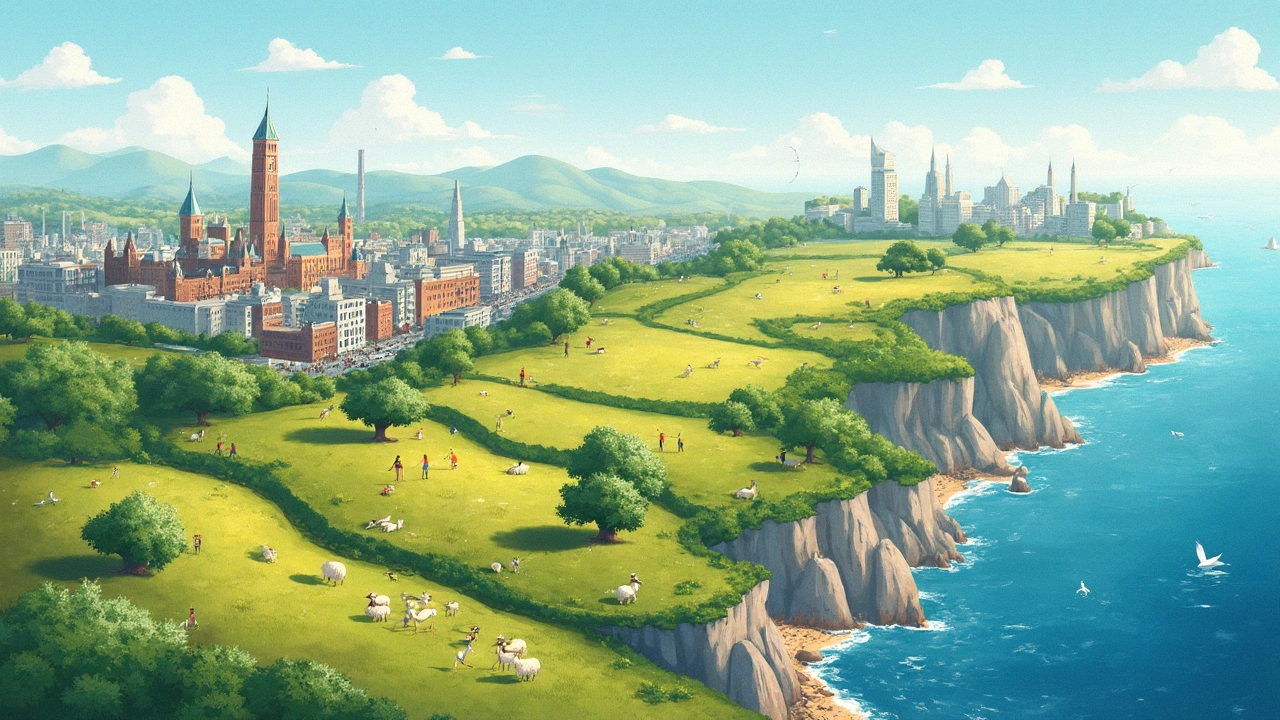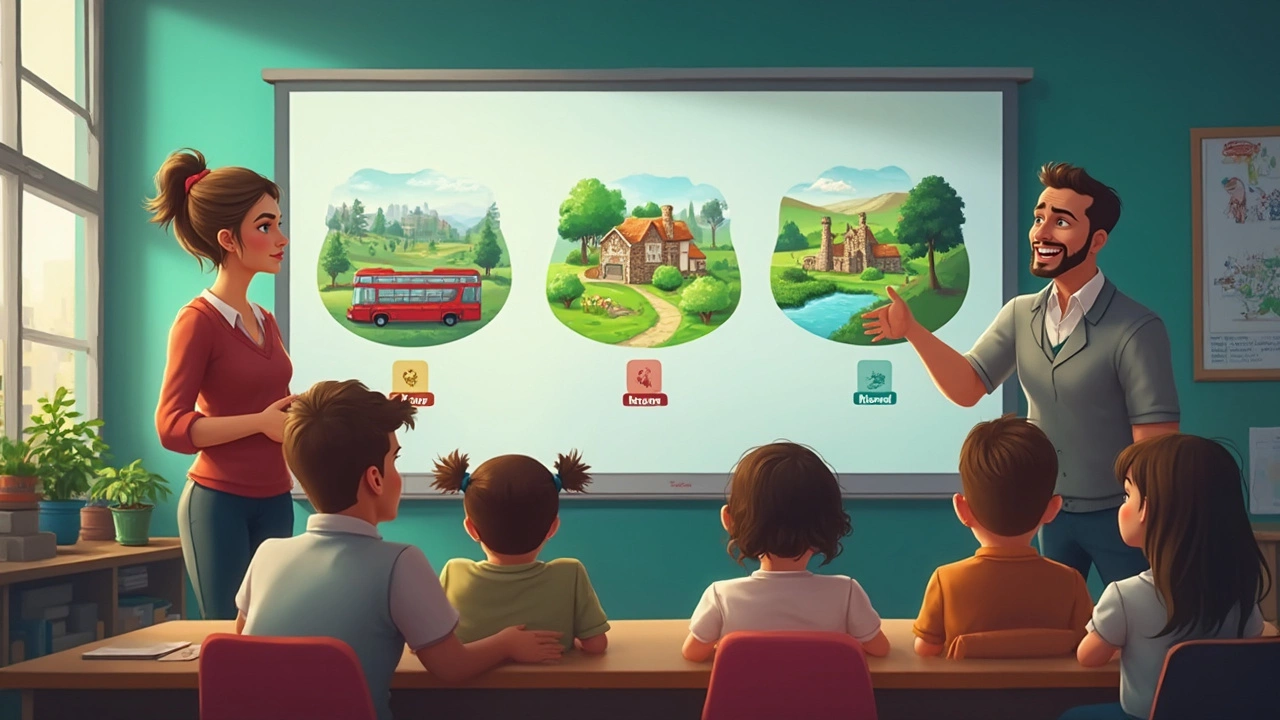Environment Categories: The 3 Main Groups Explained
 May, 25 2025
May, 25 2025
If you ask a bunch of people what "the environment" means, you’ll get a crazy mix of answers. Some will picture forests, others a busy city street, maybe your dog napping in the backyard (looking at you, Rosie). But scientists and environmental groups actually break it up into three simple categories, and knowing these makes a huge difference in how we see the world—and how we can protect it.
Understanding these groups isn’t just for school quizzes. It can help you make better choices every day, whether you’re figuring out where to walk your dog without wrecking the local greenspace or deciding how to recycle that takeout container. Each category—natural, human-made, and social—affects your life in its own way, but they’re always bumping into each other.
- Natural Environment: What Exists Without Us
- Human-Made Environment: The Stuff We Build
- Social Environment: The Way We Interact
- Why Knowing These Categories Matters
Natural Environment: What Exists Without Us
The natural environment is everything that’s out there before humans came in with bulldozers or built cities. Think forests, rivers, mountains, oceans, clean air, and even the soil in your backyard. It’s the original setup—nature in all its forms, untouched by human design.
Here’s the simple trick: if it existed before humans, it counts as natural. So, rainforests in the Amazon? Totally natural. Arctic ice? Natural. The squirrels in your local park are part of it, too. This is where plants and animals live and grow, and honestly, it’s the base for all life on Earth. All those beautiful views we sometimes take for granted? That’s the natural environment showing off.
Some common parts of the natural environment include:
- Landforms like hills, valleys, mountains, and plains
- Oceans, rivers, lakes, and other bodies of water
- Weather systems and climate zones
- Plants, animals, fungi, and even tiny microbes
Why does this matter? Well, the natural environment gives us what we need to survive—air, water, food, and materials. But it’s super fragile. For example, the Amazon rainforest is losing trees at a rate of several football fields a minute due to deforestation. When parts of the natural environment get destroyed, it messes with weather, wildlife, and even things we use every day, like clean water. No amount of technology can totally replace a lost ecosystem.
Here’s a useful tip: if you ever wonder if something fits the environment categories model, ask yourself—did humans build it or change it a lot? If not, it’s probably the natural kind. Simple, right? Respecting and protecting these wild spaces, even in small ways like picking up trash or supporting conservation groups, matters more than you might think.
Human-Made Environment: The Stuff We Build
Every time you walk into a shopping mall, use a smartphone, or chill in your living room, you’re right in the middle of the human-made environment. This category covers everything people design, build, or change—from skyscrapers to highways to your kitchen appliances. It's a pretty big deal, since it shapes how we live, work, and move around every day.
Think about it: even your coffee shop, the water pipes under the sidewalk, and the streetlights outside are part of this group. While natural environments work on their own, the human-made environment comes straight from our needs and choices. Sometimes that's great (like having clean drinking water on tap). Other times, not so much (hello, air pollution from all the cars).
To get a sense of how massive this human-made footprint is, check this out:
| Human-Made Item | Global Facts |
|---|---|
| Buildings | By 2023, people had built enough buildings worldwide to cover about 1.5 million square kilometers—almost the size of Mongolia. |
| Roads | The global road network stretches over 64 million kilometers. That’s enough to wrap around Earth more than 1,500 times. |
| Plastic | Humans have produced over 8.3 billion tons since the 1950s. Most of it still exists somewhere—landfills, oceans, or even your neighborhood park. |
Of course, not all human-made environments are cities. Rural communities, farms, and even solar farms count, too. Basically, if people created it, it’s in this box. But here’s a tip: next time you’re at home, do a quick energy check—just notice all the stuff using electricity or water. Spot anything you can turn off or unplug if you’re not using it? Little things, like that, help shrink the human-made footprint.
And one last thing—many environmental groups say cities are actually the biggest levers for change. Small tweaks, like adding more bike lanes or planting rooftop gardens, make city life greener and healthier for both people and pets (like my dog Rosie, who loves a shade tree as much as I do).

Social Environment: The Way We Interact
The social environment is all about people, their relationships, and how we shape each other's lives. This includes family, friends, neighbors, coworkers, classmates, and even the way we chat online. Unlike forests or roads, social environments lag behind in physical boundaries—they're made of connections, not concrete.
Think about it: your mood can shift in a busy café versus a quiet library. Even the rules at school or work—the way people talk, what counts as "normal"—all blend together to form the social environment. Social environments matter a lot more than most folks realize. For example, according to a major Harvard study that has been running since 1938, good relationships actually predict long life and better health more than money or fame ever will.
"The clearest message we get from this 75-year study is this: Good relationships keep us happier and healthier." — Dr. Robert Waldinger, Harvard Medical School
What shapes your social environment? It’s stuff like culture, traditions, language, laws, and the invisible rules groups set for themselves. Plus, it changes fast—think about how different your grandparent’s high school life was compared to yours.
| Area | Example | Impact |
|---|---|---|
| Family | Daily routines, support systems | Emotional health, sense of belonging |
| Work/School | Boss or teacher style, team culture | Motivation, mental wellbeing |
| Community | Neighborhood vibes, public spaces | Social safety, local traditions |
| Online Spaces | Social media groups, forums | Peer influence, exposure to ideas |
Want to improve your social environment? A few practical tips:
- Surround yourself with people who support positive life choices.
- Be aware of online influence—take regular breaks from screens.
- Get involved in local activities, even just walking your dog at the park. Neighbors notice you.
- Keep communication open in your family—honest chats boost trust.
Social environments are just as real as any forest or freeway, even if you can’t see them on a map. They shape how you feel, act, and even your health. Building a healthier social space isn’t about luck—it’s about choices, a little effort, and who you let into your world.
Why Knowing These Categories Matters
A lot of people mix up what “environment” really means, but breaking it into the three main environment categories can totally clear things up. Once you see how natural, human-made, and social environments each play a role, it's way easier to spot problems—and pitch in with solutions.
For example, the natural environment includes your city parks, lakes, and untouched forests. Human-made covers things like buildings, roads, and stuff people build. Social environment is all about relationships and the vibes at home, work, or out in your community. Here’s why grouping your surroundings like this is way more useful than dumping it all into one big basket:
- Targeted solutions. When cities make plans to cut pollution, they need to know if it's coming from nature, like pollen, or from factories and cars (human-made).
- Better policies. Government rules that work for one environment category could mess up another if planners aren’t careful. Picture protecting a wetland (natural) while building a shopping mall (human-made) nearby—it takes balance.
- Personal choices. Knowing what’s natural and what’s human-made helps you figure out how to shrink your footprint. Like, do you need to drive everywhere, or is there a walking trail in the natural environment next door?
Let’s check out some real numbers so you can see the scope of impact:
| Environment Category | Global Issue | Annual Impact (2024) |
|---|---|---|
| Natural | Deforestation | 10 million hectares lost |
| Human-Made | Urban Expansion | Over 150,000 square km added |
| Social | Work-related Stress | 264 million people affected |
If you know which environment you’re dealing with, you can make smarter choices, spend energy where it actually counts, and not feel overwhelmed by trying to “fix the environment” as one giant thing. It doesn’t matter if you’re a city planner, a dog owner (hi Rosie!), or just trying to make your day a bit greener—understanding these categories puts you a step ahead.
